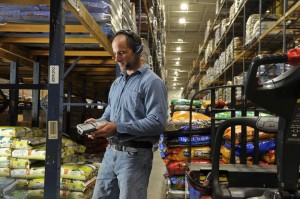Bridging the Gap
Barcodes are not only for grocery stores and libraries anymore. From tracking textbooks in schools to trees in the rainforests, it seems like people are getting more and more creative with how they track information every day. But turning this creativity into a tangible solution requires knowledge and planning.
Therefore, this blog is designed to help you lay out the backbone of your barcode solution by providing you with questions to ask yourself that, when answered, will provide you with important deciding factors that will shape your solution. Not quite sure what I mean? Keep reading to find out.
1. Where will the scanning take place?

Location of scanning is one of the biggest factors in choosing a barcode scanner, and it also plays a role in what symbology will work best for your application. Construction sites, warehouses, and other areas with potential technological hazards require one of our more rugged devices, and possibly one without a cord so that the person doing the scanning is free to move about the facility.
Locations high in dust and dirt levels will want to use durable barcodes that scan even when they are partially damaged or covered up. QR codes have a cool feature which allow you to pick the level of error correction that you desire, from approximately 7% to 30%. Be aware: using a higher error correction rate will increase the size of the barcodes produced. If you think that 30% error correction is not enough for your needs, more durable forms of media are available for our printers that can withstand even the most demanding environments.
2. What kind of information will be stored?
This is an important question when trying to decide which symbology you will be using to store information. Are you recording inventory numbers for your products? A one-dimensional barcode supporting only a limited number of digits & characters may be the right solution for you – such as Code 39 or UPC. Do you need to record comments such as product information or shipping location on each barcode? A two-dimensional barcode such as the Data Matrix or the QR code may be the best option.
Here are a few tips when deciding what information to store:
- One dimensional barcodes require a database to show which item each barcode corresponds to. For this reason many small businesses are going with two dimensional barcodes because they do not have enough items needing labelling to warrant creating a database. Check out this resource for more info on 1D vs. 2D barcodes.
- Barcodes for similar items should follow a similar format; the only information that should change from item to item within a group is the item’s unique identifiers. This allows for easier interpretation and reduction of error when humans are involved.
- Keep in mind that the data you store in a barcode is not encrypted in any way. Anybody with a smartphone can decode a barcode, so private information encoded on to barcodes still needs to be kept secure using traditional methods like those you would use to protect a confidential document.
3. What problem will be solved?
As versatile as barcodes are, sometimes they simply aren’t the right solution to the problem you’re facing. Before you make the leap and purchase a barcode scanner and printer, you want to be sure that the purchase you’re going to make will improve workflow. If you’re unsure of whether barcodes are the right option, ask yourself the following questions:
- Am I losing time and/or money to human errors?
- Is tracking my inventory taking too many resources (labor, paper/ink, etc.)?
- Are my orders often being lost or filled incorrectly?
- Are my employees getting stressed from all the tedious work they have to do?
If you answered yes to any of these, barcodes may be able to help. If you still have questions about whether or not you could take advantage of such a system, please contact us by email, phone, or Live Chat and we would love to help you out.
Create your own barcodes with our Free Online Barcode Generator. Simply choose a symbology, enter in the barcode data, and click Generate Barcode!
About the Author:
 RAD DeRose is the President and CEO of L-Tron Corporation. He has over 30 years experience in industrial automation and data collection solutions and brings a deep industry knowledge-base on the challenges faced in the commercial and public safety sectors. RAD can be reached at (800)-830-9523 ext 114 or emailed at RAD.DeRose@L-Tron.com.
RAD DeRose is the President and CEO of L-Tron Corporation. He has over 30 years experience in industrial automation and data collection solutions and brings a deep industry knowledge-base on the challenges faced in the commercial and public safety sectors. RAD can be reached at (800)-830-9523 ext 114 or emailed at RAD.DeRose@L-Tron.com.














